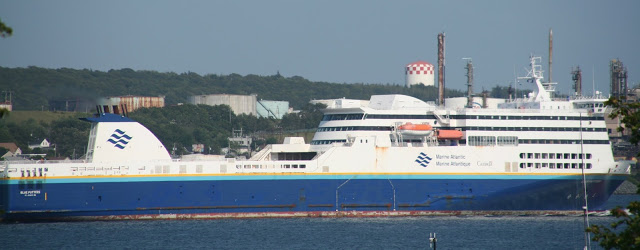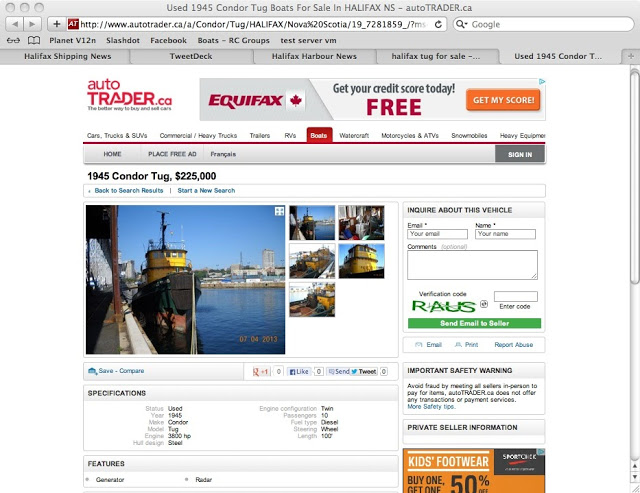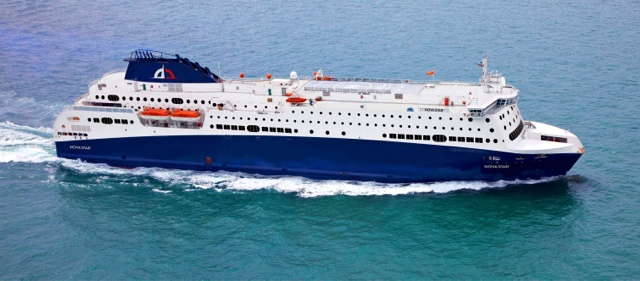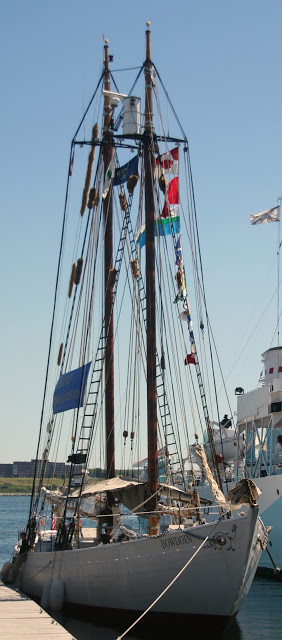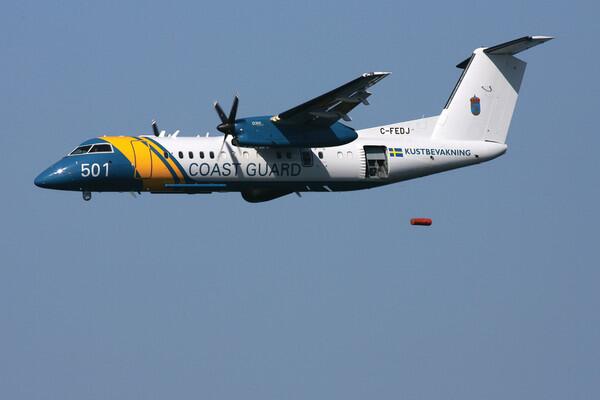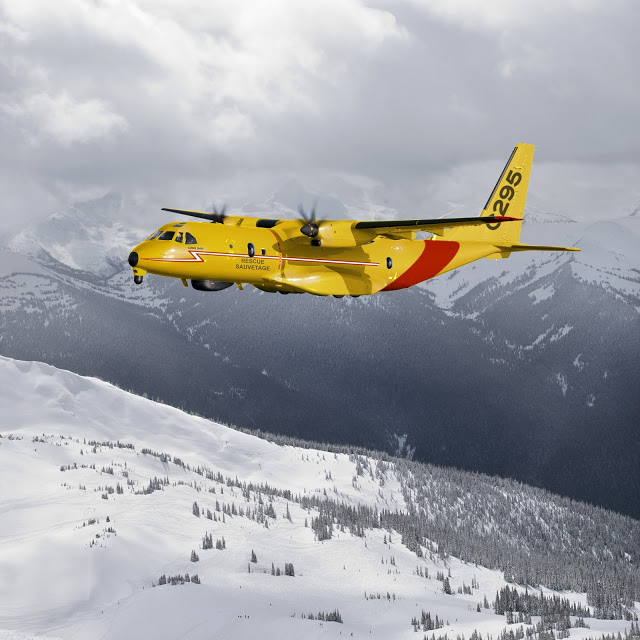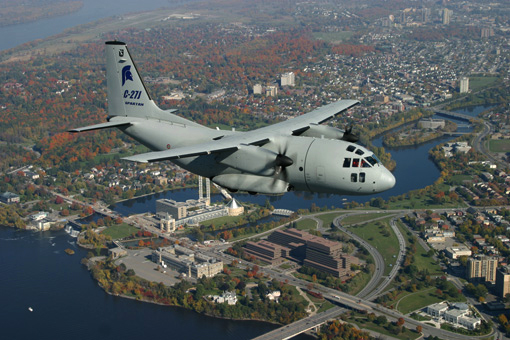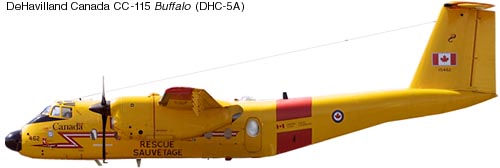Tanker Walnut Express at anchor for bunkers. She will sail later this afternoon.
Yearly Archives: 2013
New Cranes Due tommorow?
The port authority website shows the ZHEN HUA 19 due at 0630 tomorrow. When the vessel was last within AIS range on Marine traffic, the eta was 14:00.
no news on a Pilot order. Stay tuned.
UPDATE 08/20: Port now shows arrival the morning of the 23rd.
Blue Putties to Depart this afternoon.
Blue Putties is scheduled to depart Halifax Shipyards this afternoon. Recent Past ferry departures have been delayed affairs – we will see if this one is on schedule.
UPDATE: She was, she left the dock just after 15:30, and headed outbound. (Below – Close up of the repaired and re-painted bow)
The Chronicle Herald reports that Marine Atlantic stated they expect her to resume service Tuesday evening, though she does not appear to be on the schedule.
the SS Royal William
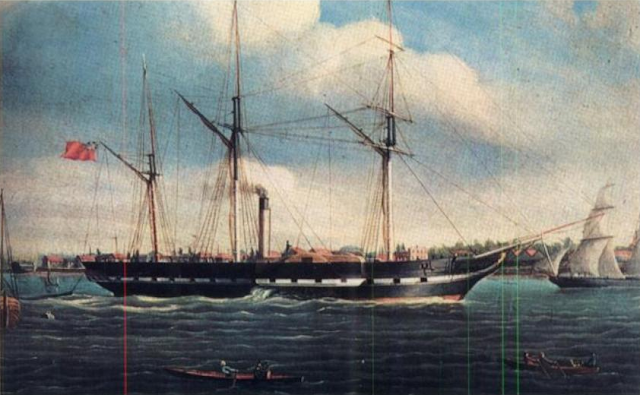
SS Royal William was a Canadian steamship that is sometimes credited with achieving the first crossing of the Atlantic Ocean to be made almost entirely under steam power, using sails only during periods of boiler maintenance
She was commissioned by brewer John Molson and a group of investors, built in Cape Blanc, Quebec by John Saxton Campbell and George Black she was launched on 27 April 1831. The steam engines were made and installed in Montreal. She made several trips between Quebec and the Atlantic colonies in 1831. Her owners decided to sail her to Europe and find a buyer. She departed from Pictou, Nova Scotia on 18 August 1833 with seven passengers, a small amount of freight and a load of coal and arrived at Gravesend on the River Thames after a 25-day passage.
Royal William was eventually sold to the Spanish Navy where she served for many years and earned the distinction of being the first steamship to fire a shot in anger during a minor Spanish rebellion.
One of Royal William’s co-owners was Samuel Cunard a merchant from Halifax Nova Scotia who drew important lessons from the ship which he applied when he founded the Cunard Steamship Company a few years later.
Craig Trans For Sale – On AutoTrader
Seems Craig trans still has hope for life… See the ad yourself at http://www.autotrader.ca/a/Condor/Tug/HALIFAX/Nova%20Scotia/19_7281859_/?ms=boats&showcpo=ShowCPO
From the Archives: Fireboat
Yarmouth Ferry Bid Selected
From the Press Release:
Economic and Rural Development and Tourism Minister Graham Steele announced today, Aug. 13, the province will enter into negotiations with STM Quest Inc., a proposed joint venture between ST Marine Ltd. and Quest Navigation, to set up and run a ferry between Yarmouth and Portland, Maine.
Three companies submitted business plans to operate the ferry service from Yarmouth to Maine, beginning next year. The flexible process allowed the evaluation team to communicate with the companies, requesting more information, asking questions about the plans they submitted and meeting with each of them.
After the thorough process, the team chose to begin negotiations with STM Quest Inc.
“We would like to thank the government of the province of Nova Scotia for their confidence in selecting us to help restore this vital service,” said Steve Durrell, COO of Quest Navigation. “We would also like to assure all Nova Scotians that we will devote our efforts to delivering the best value and a world-class cruise ferry service that will benefit all the people of Nova Scotia and serve as a symbol that makes everyone proud.”
A team of representatives from the Nova Scotia International Ferry Partnership and the province evaluated the plans based on financial stability, a management structure with expertise and a history of managing successful ferry services, and tourism and marketing experience.
“It’s encouraging to see this process continue to move ahead on such an important transportation link,” said Keith Condon, co-chair of the Nova Scotia International Ferry Partnership. “Knowing the province is entering negotiations on a proposal that would see a ferry in Yarmouth in 2014 is good news for the community and we are looking forward to a final announcement.”
The province remains committed to investing up to $21 million over seven years to a qualified operator with a viable and sustainable business plan showing a viable service
For more on Quest’s Previous Proposal, See This Post
15 Films about Canadian Aviation
Courtesy of the National Film Board – I5 films about Canadian Aviation.
You can see all 15 via the NFB Blog
Birth of a Giant (1957)
This film tells the story of the conception, construction and testing of the Canadair CP-107 Argus
Birth of a Giant by Hugh O'Connor, National Film Board of Canada
Bowdoin Visits Again.
Fixed Wing SAR
(Above Left-Right) CC-115 Buffalo, CC-138 Twin Otter, CC-130 Hercules (DND Combat Camera Photo) Above we have the Existing Fixed Wing SAR Fleet. The Buffalo and Twin Otter are both DeHavilland Canada Designs, and the C130 is built by Lockheed.
The RCAF currently designates 13 CC130H Hercules and six CC115 Buffalo aircraft for FWSAR response. The Hercules operate from CFBs Greenwood, Trenton, and Winnipeg, while the Buffalos are all based at CFB Comox. Of these, the six Buffalos and the Hercules at Greenwood and Trenton are dedicated to SAR. The Buffalos have been in service since the 1960s, while many of the Hercules date from the1970s, and all are now approaching the end of their effective service lives. The RCAF Twin Otters are currently based in Yellowknife.
its worth noting that canada currently has two Models of C130 – H and J. the J models are current and are used for transport. the Older H models are dedicated to SAR.
The Contenders:
Dash-8 with Field Air Operable Door
The Dash8, is also a DeHavilland Canada design though now built by Bombardier and marketed as the Q400. The Stock aircraft is modified for SAR use by Field Aviation, and includes an air operable side doors. it has the longest range after the C130, is built in Canada, and the modification is in use with 29 Aircraft already in service. Transport Canada’s Arial surveillance program uses Dash-8 -100 aircraft, so the type is quite Familiar to Canadian’s (Porter and Westjet Encore also use the type exclusively)
The above Photo shows a Swedish plane, prior to delivery, still with Canadian Registration.
Airbus Military C295
Viewed from the onset as the favorite by DND, This Italian aircraft began as the Fiat g.222 and was updated in partnership with Lockheed. One benefit is that the C-27J is in many ways compatible with a C130. It is the Fastest, and has the longest range, but it is also the heaviest, limiting use on northern airstrips, and features poor low speed performance. It should be noted that the Italians don’t use the aircraft for FWSAR, Favoring much smaller aircraft, and leaning towards a variant of the ATR-42 commuter plane, a contemporary of the Q400.
Viking Air DHC-5NG Buffalo
Viking Air Purchased the type certificates for All Dehavilland Canada Aircraft except the Dash-8. The DHC-5NG is a proposed new production run of the Same aircraft to be replaced. the aircraft would be outfitted with modern systems and electronics, however the airframe would remain the same. Viking recently re-launched Twin Otter Production, with a modernized airframe and has had good success with it. The Buffalo is certainly suited to the Job – It performs it currently, and the aircraft is light, and has good slow speed performance. Its not pressurized however, so Altitude is Limited.
The Original development of the Buffalo occurred at the same period as the g.222, predecessor of the C27J
| C-27J | DHC-5NG | C-295 | Q400 | HC-130J | |
|---|---|---|---|---|---|
| Wing span | 94′ 2″ | 96′ 0″ | 84′ 8″ | 93′ 3″ | 132′ 7″ |
| Overall length | 74′ 6″ | 79′ 0″ | 80′ 4″ | 107′ 9″ | 97′ 9″ |
| Overall height | 34′ 8″ | 28′ 8″ | 28′ 5″ | 27′ 5″ | 38′ 9″ |
| Cabin length | 28′ 1″ | 31′ 5″ | 41′ 8″ | 61′ 8″ | 40′ 0″ |
| Cabin width | 8′ 0″ | 8′ 9″ | 8′ 10″ | 6′ 8″ | 9′ 9″ |
| Cabin height | 7′ 4″ | 6′ 10″ | 6′ 10″ | 6′ 5″ | 9′ 0″ |
| Operating Weight Empty [lbs] | 37,480 | 24,000 | 24,251 | 39,284 | 89,000 |
| Max Take Off Weight [lbs] | 70,106 | 49,200 | 51,150 | 65,200 | 164,000 |
| Max Payload [lbs] | 19,842 | *18,000+ | 20,400 | 18,716 | 35,000 |
| Maximum speed [knots] | 325 | *300+ | 311 | 360 | 360 |
| Range [nm] | 2,300 | *600+ | 2,430 | 1,500-3,000 | 3,480 |

